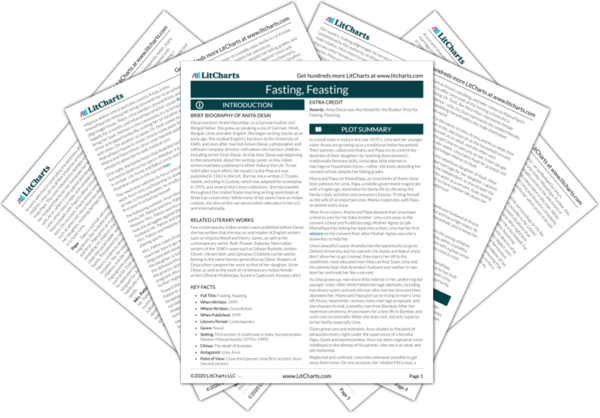Summary
Analysis
The chapter opens with a scene in the modern day, in the summer in India. Uma’s mother tells her to pass the fruit bowel to her father, but Papa remains still and silent and does not take it. Mama interprets this silence as his nonverbal demand that the women peel and part the fruit for him. Following her mother’s instructions, Uma helps her mother to silently feed her father an orange in an elaborate, almost-ceremonial process, and when it is over, her mother sits back, proud and relieved.
Papa feels so self-important that he does not even use words to express his demands. Mama accommodates Papa’s sense of entitlement, and she considers waiting upon him to be a duty of not only herself, but also her daughter. Something as simple as eating an orange becomes a ceremony for Mama to proudly show her submission to Papa as patriarch, and to impose the same submission onto Uma.
Themes
The novel flashes back to Uma’s teenage years, after her baby brother Arun is born. While everyone else is napping during a hot afternoon, Uma runs away from home. She hires a rickshaw (a two-wheeled wooden cart, pulled by a man on a bicycle)—to ride her to the convent school. There, she goes in search of Mother Agnes, the head nun, and falls at her feet, begging her to allow her to return to school, telling of her unhappiness at home with the baby. Mother Agnes embraces Uma, then tells her that she has done everything she can to convince Papa, and that now Uma should try to learn home keeping. Uma shrieks, and has her first epileptic seizure on the convent floor. Mama blames the convent nuns for causing Uma’s seizure, using the incident to justify her decision to keep Uma out of school.
Uma is desperate to nurture a spirit of rebellion. She escapes to the convent school because it was the only place where she had her own separate daily existence and the promise of a future outside of MamaPapa, marriage and children. She sees Mother Agnes as an authority figure—who she believes has the power to stand up to her parents. Rather than find the support that she hopes for, however, she finds that not even Mother Agnes can advocate for Uma. She is left to face her fate, alone. Uma’s seizure on the convent floor seizure represents the quiet rebellion of Uma’s spirit and body against the life she has been assigned. Yet rather than help her to gain independence, the seizures only further hinder her.
Themes
Uma settles into taking care of baby Arun. Mama and Papa attend nervously to Arun’s care, worrying over his diet, his every step, his progress, and making sure he has the best of everything. Uma observes that Arun’s birth is a great pride for Mama—who, to Uma’s dismay, bases her happiness on her status as the mother of the son by an important politician. Uma forms the conclusion over the years that her mother and father appear to connect solely as partners in running their household, and not in any romantic way. Uma thinks to herself that she wouldn’t like to have a marriage without love. Arun grows up to be sickly and weak, and he refuses even as a baby to eat meat. This greatly distresses his parents, who see meat as a sign of power and progress, and think of vegetarianism as rustic and old-fashioned.
Uma’s independent way of thinking is evident in her differing opinion that love should be at the heart of marriage—contrary to the norm for arranged marriages. The care that MamaPapa have for Arun is unequal to the care they put on their daughters, showing how they treat daughters as second-class children. Yet, they deny Arun self-expression, just as they deny it of their daughters, when at an early age MamaPapa fail to accept his vegetarianism. His weak immune system and his dislike of meat set the stage for him to disappoint the high expectations of his parents.
Themes
The story flashes forward briefly a few years, to Arun as a little boy playing in the bushes outside with Uma. She is sneaking unripened fruit and salt to him as a snack, and she reminds him of a time when he bit her on the finger as a baby. He does not think it is funny, and he threatens to tell their parents that Uma is sneaking forbidden snacks to him. This scares Uma, who jumps up and gets caught in the bushes, but Arun just laughs.
Even as a little boy, Arun already knows that he has a more powerful place within the family than his older sister Uma. He uses his power as the boy child to threaten and scare Uma, as a way of manipulating her into keeping him happy. He is still a child and therefore playful, but the effect his threats have on Uma are real.
Themes
Get the entire Fasting, Feasting LitChart as a printable PDF.













